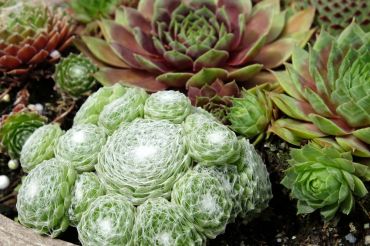
Sempervivum means ‘always alive’, and it’s a good description of these attractive and easy-to-grow succulents. Sempervivums come mainly from mountainous regions and cope well with both drought and cold. With their neat, geometric rosettes of fleshy leaves, they look great all year round in troughs or pots in a sunny spot, needing very little care.
Where to Plant Sempervivums
Sempervivums don’t need much to grow – they will thrive in cracks in walls and have traditionally been grown on the roofs of houses, hence their common name of houseleeks. They like plenty of sunshine and can be grown in the ground in very well-drained soil or pots filled with well-drained compost.
Plant Sempervivums in pots in a 3:1 mix of loam-based compost such as John Innes No. 3 and horticultural grit. Place them sitting slightly above the compost level so that there is space to top-dress it with a layer of grit. As well as looking good, this stops the compost splashing onto the leaves when it rains, causing them to rot.
Sempervivums don’t need regular feeding, but it’s a good idea to repot them into fresh compost each year or feed them annually with a balanced liquid feed.
Once a rosette has flowered, it will die, but will quickly be replaced by offsets – these are smaller rosettes that grow from the main stem.
Propagating Sempervivums From Offsets
Propagating sempervivums from offsets is very simple. Here’s how it’s done:
- Cut offsets off the main plant with a sharp knife, ideally with some roots attached.
- Remove most of the fleshy leaves from the offset base, leaving just a small ring of leaves in place. This reduces the risk of leaves rotting off.
- Fill individual small pots with a 50/50 mix of loam-based compost such as John Innes No 1 and horticultural grit.
- With a dibber or pencil, make a small hole in the compost in each pot and plant an offset in the hole. Firm the compost gently around the offset.
- Water well and place the pots somewhere sheltered. After around 3 months, the offsets should have rooted and can be planted out.
Sempervivum Varieties to Grow
There are so many beautiful sempervivums to choose from, and it can be hard to know where to start! Here are five of our favourites:
- Cobweb houseleek (Sempervivum arachnoideum): rosettes of red-tipped green leaves, with a delicate cobweb of white threads over the tips of the leaves.
- Sempervivum ‘Pippin’: deep green leaves tipped with deep maroon-red.
- Sempervivum ‘Purple Dazzler’: narrow pointed leaves, green at the tips and deep burgundy red at the centres. The colour gets more intense in winter.
- Sempervivum ‘Eddy’: spoon-shaped red leaves, darker red at the centres.
- Sempervivum ‘Brunneifolium’: large rosettes of pale pinkish-grey leaves with a metallic tinge.
Whether you’re planting up a pot or filling a border, you’ll find plenty of plants to choose from in our great ranges. Visit us today and add some extra colour to your garden!




